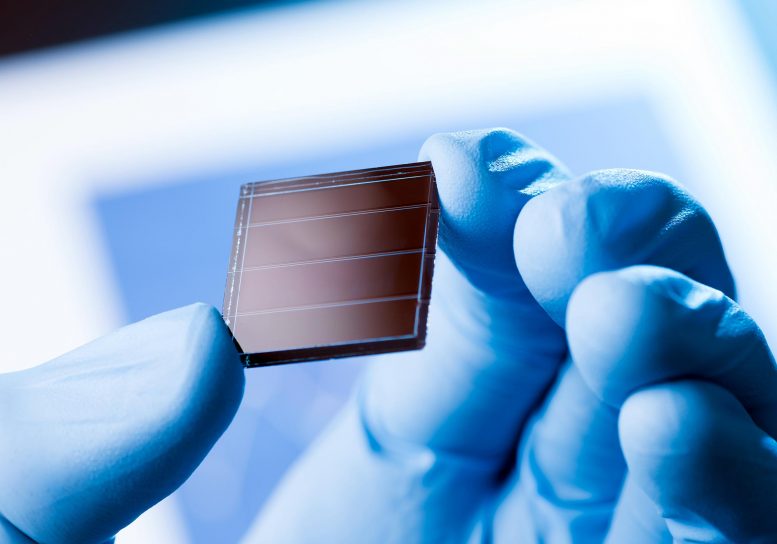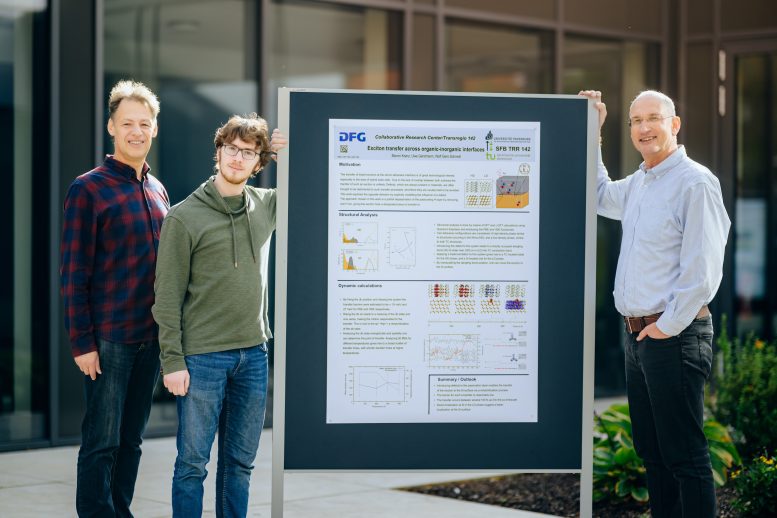
Physicists at Paderborn University have enhanced solar cell efficiency significantly using tetracene, an organic material, based on complex computer simulations. They discovered that defects at the tetracene-silicon interface boost energy transfer, promising a new solar cell design with drastically improved performance.
Physicists at Paderborn University have used complex computer simulations to create a novel solar cell design that boasts substantially higher efficiency than existing options. The enhancement in performance is attributed to a slender coating of an organic compound named tetracene. The results have recently been published in the renowned journal 
(From left to right) The authors Prof Dr Uwe Gerstmann, Dr Marvin Krenz and Prof Dr Wolf Gero Schmidt with their poster on energy transport in the solar cell. Credit: Paderborn University, Besim Mazhiqi
Schmidt explains: “In order to increase the efficiency, the silicon solar cell can be provided with an organic layer, for example, made from the semiconductor tetracene. Short-wave light is absorbed in this layer and converted into high-energy electronic excitations, so-called excitons. These excitons decay in the tetracene into two low-energy excitations. If these excitations can be successfully transferred to the silicon solar cell, they can be efficiently converted into electricity and increase the overall yield of usable energy.”
Decisive breakthrough for rapid energy transfer
The excitation transfer of tetracene into silicon is being investigated by Schmidt’s team using complex computer simulations at the Paderborn Center for Parallel Computing (PC2), the university’s high-performance computing center. A decisive breakthrough has now been achieved: in a joint study with Dr. Marvin Krenz and Prof. Dr. Uwe Gerstmann, both also from Paderborn University, the scientists have shown that special defects in the form of unsaturated chemical bonds at the interface between the tetracene film and the solar cell dramatically accelerate the exciton transfer. Schmidt: “Such defects occur during the desorption of hydrogen and cause electronic interface states with fluctuating energy. These fluctuations transport the electronic excitations from the tetracene into the silicon like a lift.”
Such “defects” in solar cells are actually associated with energy losses. This makes the results of the trio of physicists all the more astonishing: “In the case of the silicon tetracene interface, the defects are essential for the rapid energy transfer. The results of our computer simulations are truly surprising. They also provide precise indications for the design of a new type of solar cell with significantly increased efficiency,” the physicist states.
Reference: “Defect-Assisted Exciton Transfer across the Tetracene-Si(111):H Interface” by Marvin Krenz, Uwe Gerstmann and Wolf Gero Schmidt, 16 February 2024, Physical Review Letters.DOI: 10.1103/PhysRevLett.132.076201